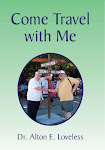My wife and I boarded an underground train (commonly called the tube in London) to visit the old and still famous church called The Metropolitan Temple. It was nearing sun down by the time we reached the tube gate at Elephant Circle. After walking the stairway to the street level we started a couple blocks until we reached what is the front of the church. Only the front of the original church still stood, for the Tabernacle of Charles Spurgeon's time burned down in 1898 (excepting the front portico and basement), and rebuilt along similar lines. It was later burned down for the second time when hit by an incendiary bomb in the longest air raid of World War II (in May 1941). Once again the portico and basement survived, and in 1957 the Tabernacle was rebuilt on the original perimeter walls, but to a different design, obviously taking away from what was probably a most beautiful place during the time the famous Spurgeon pastored here.
Now the sun was hidden and darkness filled the barren, creepy streets as my wife and I hasten back to the underground railway gate to get back to the hotel at a safe time.
Having more than a simple interest in this famous church I picked up a book the next day which started my research into its history which I will be briefly share.
The fellowship of this famous congregation goes back to the year 1650, thirty years after the sailing of the Pilgrim Fathers to America, and at the time that Parliament had just banned Baptist meetings. The meeting grew rapidly under its first pastor, William Rider, who apparently died in the plague. Then Benjamin Keach came who led the church through much persecution, and built its first chapel near Tower Bridge as soon as freedom came to Baptists in 1688.
Dr John Gill became the pastor in 1720 and served for 51 years. He was one of the greatest biblical scholars of his time. Then came Dr John Rippon (in 1771), who served for 63 years, building the church so that it became the largest Baptist congregation in that time.
The next long and notable pastorate was that of C. H. Spurgeon in 1853. His arrival soon led to such crowds thronging the chapel that services had to be moved to a vast hired hall in the Strand, and then to the Royal Surrey Gardens Music Hall, where up to 10,000 people assembled. During his ministry he had built up a congregation of 6,000 and added 14,692 members to the church.
The present site was thought to be the site of the burning of the Southwark Martyrs. For this reason the foundation-stone bears the words: 'The blood of the martyrs is the seed of the church.” C. H. Spurgeon pastored the church for 38 years, founding a pastors' college, an orphanage, a Christian literature society and The Sword and the Trowel magazine. Over 200 new churches were started in the Home Counties alone, and pastored by his students. His printed sermons fill 62 volumes.
Some years ago I gave to one of the colleges I graduated from, a first edition of one of Spurgeons books entitled, Lectures to my Students, with a presentation therein “To Rev. Charles Davis from Mrs. C. H. Spurgeon.” Needless to say it is a collector’s item.
We have grown to the twilight of our life, but know the future of which these great preachers ministered is shortly to come.
“How beautiful are the feet of them that preach the gospel of peace, and bring glad tidings of good things! “--Romans 10:15
In the words of an old Episcopal bishop, Phillip Brooks, “If God called you to preach, never stoop to be a king.”





No comments:
Post a Comment